
The Civic Centre is a municipal building located in the Cultural Quarter area within the city of Southampton, England. It comprises offices occupied by Southampton City Council, the SeaCity Museum, the Guildhall, the Southampton City Art Gallery, and the city library. It was designed by the English architect Ernest Berry Webber in the Classical style in 1929 and constructed over a ten-year period. It was completed in 1939. Pevsner's Hampshire: South describes it as "the most ambitious civic building erected in the provinces in the interwar years". It was designated as a Grade II* listed building in 1980.

Swindon Town Hall is a former municipal building in Swindon, England which was built in 1891 to be a centrepiece of New Swindon. It is currently used by Swindon Dance, a national dance agency. It is a Grade II listed building.

Barry Council Office and Library is a local government building and public library located in King Square, Barry, Wales. The building, which was once the meeting place of Barry Municipal Borough Council, is a Grade II listed building.
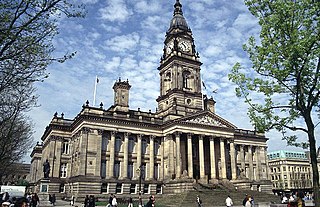
Bolton Town Hall in Victoria Square, Bolton, Greater Manchester, England, was built between 1866 and 1873 for the County Borough of Bolton to designs by William Hill of Leeds and George Woodhouse of Bolton. The town hall was extended in the 1930s to the designs of Bradshaw, Gass and Hope and has been designated a Grade II* listed building by English Heritage.
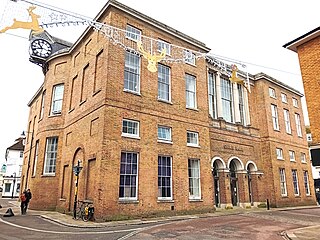
The Shire Hall is a municipal building in Fore Street, Hertford, the county town of Hertfordshire, England. The building, which currently serves as a Magistrates' Court, is a Grade I listed building.

Croydon Town Hall is a council building in Katharine Street, Croydon which serves as the headquarters for Croydon London Borough Council. It is a Grade II listed building.
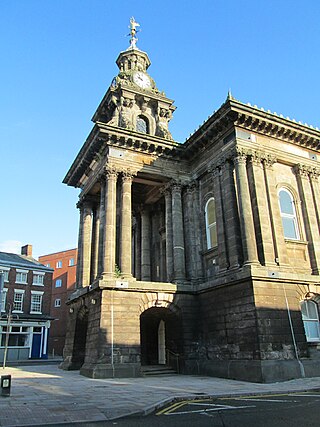
The Old Town Hall is a former town hall in Burslem, in Staffordshire, England. It is in the Market Place, in the centre of the town. It is a Grade II* listed building, listed on 2 October 1951.

Wolverhampton Civic Centre is a municipal building in the City of Wolverhampton, West Midlands, England. The building houses a council chamber for City of Wolverhampton Council.

Barking Town hall is a municipal building in Clockhouse Avenue, Barking, London, England. The town hall, which is the headquarters of Barking and Dagenham London Borough Council, is a locally listed building.

Burnley Town Hall is a municipal building in Manchester Road, Burnley, Lancashire, England. The town hall, which is the headquarters of Burnley Borough Council, is a Grade II listed building.
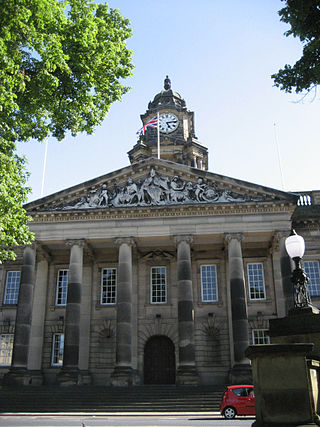
Lancaster Town Hall is a municipal building in Dalton Square, Lancaster, Lancashire, England. It was built in 1909 and is a Grade II* listed building.

The Guildhall is a municipal building in High Street, Newcastle-under-Lyme. It is a Grade II listed building.

Berkhamsted Town Hall is a municipal building in the High Street, Berkhamsted, Hertfordshire, England. It is a Grade II listed building.

Rotherham Town Hall is a municipal building in The Crofts, off Moorgate Street in Rotherham, South Yorkshire, England.

Preston Town Hall is a municipal building in Lancaster Road in Preston, Lancashire, England. The town hall, which is the headquarters of Preston City Council, is a Grade II listed building.

Darwen Town Hall is a municipal building in Croft Street, Darwen, Lancashire, England. It is the meeting place of Darwen Town Council.

Great Yarmouth Town Hall is a municipal building in Hall Plain, Great Yarmouth, Norfolk, England. The town hall, which is the meeting place of Great Yarmouth Borough Council, is a Grade II* listed building.

Maidstone Town Hall is a municipal building in Middle Row, Maidstone, Kent, England. The town hall, which is a meeting place of Maidstone Borough Council, is a Grade II* listed building.
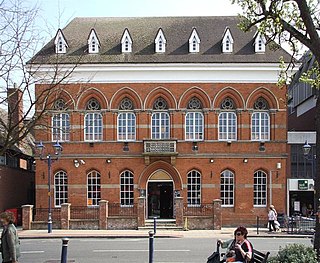
The Old Council House is a former municipal building in Poplar Road, Solihull, West Midlands, England. The town hall, which was the meeting place of Solihull Borough Council, is now a public house.

Liskeard Guildhall is a municipal building in Pike Street, Liskeard, Cornwall, England. The structure, which was the meeting place of Liskeard Borough Council, is a Grade II* listed building.





















